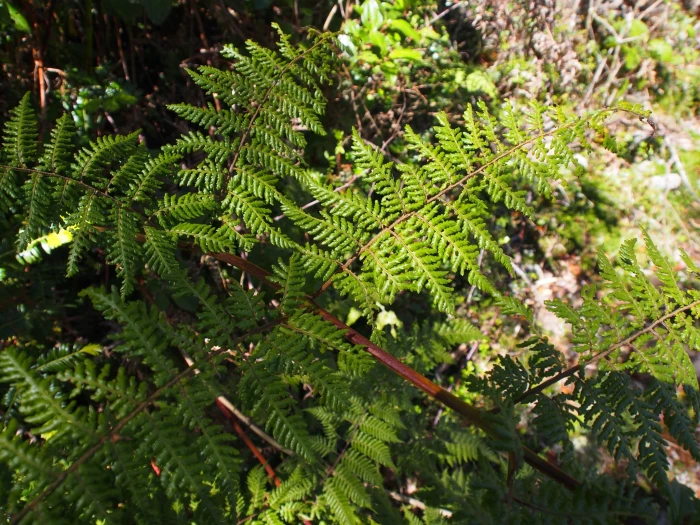Diamondleaf Fern
(Lophosoria quadripinnata)
Diamondleaf Fern (Lophosoria quadripinnata)
/
/

Lena Struwe
CC BY-SA 4.0
Image By:
Lena Struwe
Recorded By:
Copyright:
CC BY-SA 4.0
Copyright Notice:
Photo by: Lena Struwe | License Type: CC BY-SA 4.0 | License URL: http://creativecommons.org/licenses/by-sa/4.0/ | Rights Holder: Lena Struwe | Publisher: iNaturalist | Date Created: 2017-03-13T10:25:22-07:00 |
























Estimated Native Range
Climate Requirements
| • Precipitation | 20" - 259" |
| • High Temp. | 50°F - 96°F |
| • Low Temp. | 20°F - 72°F |
Summary
Lophosoria quadripinnata, commonly known as the diamondleaf fern, is a perennial herbaceous fern native to a wide range of habitats in the Americas, from the cloud forests of Cuba and Mexico to the temperate rainforests of Chile, including the Juan Fernández Islands. It is also found in the humid valleys of western Neuquén and Río Negro Provinces in Argentina. This fern typically grows to a height of 4 to 5 feet, with a similar spread, and is characterized by its large, multiple pinnate fronds that can give a tropical appearance to the landscape.
The diamondleaf fern is appreciated for its ornamental value, with its impressive size and the intricate texture of its fronds making it a striking addition to shade gardens, woodland plantings, and as a specimen plant in large containers. It thrives in moist, well-drained soils rich in organic matter and prefers partial to full shade, mimicking its natural cloud forest habitat. While it requires consistent moisture, it is important to avoid waterlogged conditions. The fern is relatively low-maintenance once established and is not commonly affected by pests or diseases. Its ancient lineage, dating back to the Cretaceous Period, and unique spore morphology add an element of historical intrigue for plant enthusiasts.CC BY-SA 4.0
The diamondleaf fern is appreciated for its ornamental value, with its impressive size and the intricate texture of its fronds making it a striking addition to shade gardens, woodland plantings, and as a specimen plant in large containers. It thrives in moist, well-drained soils rich in organic matter and prefers partial to full shade, mimicking its natural cloud forest habitat. While it requires consistent moisture, it is important to avoid waterlogged conditions. The fern is relatively low-maintenance once established and is not commonly affected by pests or diseases. Its ancient lineage, dating back to the Cretaceous Period, and unique spore morphology add an element of historical intrigue for plant enthusiasts.CC BY-SA 4.0
Plant Description
- Plant Type: Fern
- Height: 10-20 feet
- Width: 3-6 feet
- Growth Rate: Moderate
- Flower Color: N/A
- Flowering Season: Non-Flowering
- Leaf Retention: Evergreen
Growth Requirements
- Sun: Part Shade, Full Shade
- Water: Medium
- Drainage: Medium
Common Uses
Border Plant, Low Maintenance, Potted Plant
Natural Habitat
Native to cloud forests and temperate rainforests in the Americas
Other Names
Common Names: Fern Tree, Cuero de Piojo, Diamondleaf Fern, Helecho O Palmita De Valdivia, Palmilla, Silver Fern
Scientific Names: Lophosoria quadripinnata, Alsophila affinis, Alsophila bilineata, Alsophila christii, Alsophila deckeriana, Alsophila deckeriana, Alsophila glauca, Alsophila glauca, Alsophila millefolium
GBIF Accepted Name: Lophosoria quadripinnata